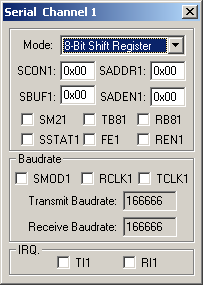|
||
| Products Download Events Support Videos | ||
Product Information
Device Database®
Downloads
Compliance Testing
Distributors
Peripheral Simulation
For Silicon Laboratories, Inc. C8051F021 — Serial UART 1 (Enhanced Interface)
Simulation support for this peripheral or feature is comprised of:
- Dialog boxes which display and allow you to change peripheral configuration.
- VTREGs (Virtual Target Registers) which support I/O with the peripheral.
These simulation capabilities are described below.
Serial Channel 1 Dialog

The Serial Channel dialog displays and allows you to edit the configuration of the Serial Interface.
- Mode displays and allows you to change the serial interface mode of operation (data bit length and baud rate).
- SCON1 (Serial Control Register 1) holds the control and setup information for programming the serial port.
- SBUF1 (Serial Interface Buffer Register 1) contains the transmit data to be sent or received data.
- SADDR1 (Slave Address) when the MCU is a master, this selects a slave device for communication with another serial device.
- SADEN1 (Slave Address Mask) determines which bits of the slave address are used for communication with another serial device.
- SM21 (Enable Serial Port Multiprocessor Communication In Modes 2 and 3) is set to suppress a receiver interrupt (RI1) if the received 9th data bit is 0.
- TB81 (Serial Port Transmitter Bit 9) is the 9th data bit to be transmitted for serial modes 2 and 3.
- RB81 (Serial Port Receiver Bit 9) is set for serial modes 2 and 3 when a 9th bit is received. In serial mode 1, this is the stop bit.
- SSTAT1 (Status Mode Select) is set to enable framing error, receiver overrun and transmitter collision detection.
- FE1 (Framing Error Detected) is set when an invalid stop bit (framing error) is detected. This bit must be reset by software.
- REN1 (Receiver Enable) is set to enable serial data input.
BaudRate
- SMOD1 (Double Baudrate) is set to double the baudrate in mode 2.
- RCLK1 (Receive Clock Enable) is set to use Timer 2 overflows for the receive clock. If reset, Timer 1 overflows are used.
- TCLK1 (Transmit Clock Enable) is set to use Timer 2 overflows for the transmit clock. If reset, Timer 1 overflows are used.
- Transmit & Receive Baudrate is the actual baudrate for the serial channel. It can be derived from the oscillator frequency, or generated by Timer 1.
IRQ
- TI1 (Transmitter Interrupt Flag) is set by hardware for each character frame transmitted. TI1 is cleared by software.
- RI1 (Receiver Interrupt Flag) is set by hardware for each character frame received. RI1 is cleared by software.
SxIN VTREG
Data Type: unsigned int
The SxIN VTREG represents the serial input of the simulated microcontroller. Values you assign to SxIN are input to the serial channel 0, 1, 2, and so on. You may assign input using the command window. For example,
S0IN='A'
causes the simulated microcontroller serial input 0 to receive the ASCII character A. If you want to use the SxIN VRTEG to simulate reception of multiple characters, you must be sure to delay for at least one character time between successive assignments to SxIN. This may be done using a signal function. For example:
signal void send_cat (void) {
swatch(0.01); /* Wait 1/100 seconds */
S0IN='C'; /* Send a C */
swatch(0.01);
S0IN='A';
swatch(0.01);
S0IN='T';
}
You may use the SxIN VTREG to input more than 8 bits of data. For example,
S0IN=0x0123
inputs a 9-bit value. This is useful if you use 9-bit serial I/O. In addition to the SxIN VRTEG, the serial window allows you to input serial characters by simply typing. Serial characters that are transmitted byt the simulated microcontroller appear in the serial window.
SxOUT VTREG
Data Type: unsigned int
The SxOUT VTREG represents the serial output from the simulated serial port 0, 1, and so on. Whenever the simulated serial port transmits a character, the value transmitted is automatically assigned to SxOUT (which is read-only). You may read the value of SxOUT to determine the character transmitted by your simulated program. For example,
S0OUT
outputs the value of the last character transmitted by serial port 0. SxOUT Format (16-bit Register)
- Bits 0-7: Data (5, 6, 7, or 8 bits)
- Bit 8: Parity bit Value
- Bit 9: Parity bit Presence (0=Not present, 1=Present)
- Bit 10: Invalid Stop bit (0=Normal, 1=Invalid)
For example:
S0OUT & 0x00FF // Data S0OUT & 0x0200 // Parity bit is present S0OUT & 0x0100 // Parity bit value (0=0, 0x0200=1)
Note that you cannot assign values to the SxOUT VTREGs. You may use the SxOUT VTREG in a script to process transmitted data. For example,
signal void s0out_sig (void) {
while (1)
{
wwatch(S0OUT); /* wait for something in S0OUT */
printf ("Transmitted a %2.2X\n", (unsigned) S0OUT);
}
}
ProductsDevelopment Tools |
Hardware & Collateral |
Downloads |
Support |
Contact |
